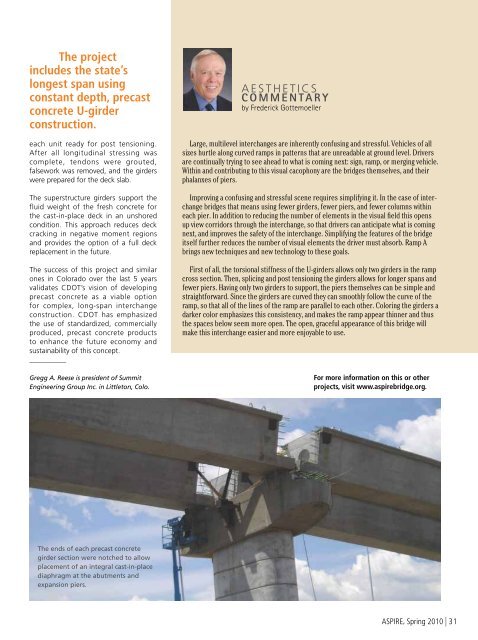ASPIRE Spring 10 - Aspire - The Concrete Bridge Magazine
ASPIRE Spring 10 - Aspire - The Concrete Bridge Magazine
ASPIRE Spring 10 - Aspire - The Concrete Bridge Magazine
Create successful ePaper yourself
Turn your PDF publications into a flip-book with our unique Google optimized e-Paper software.
<strong>The</strong> project<br />
includes the state’s<br />
longest span using<br />
constant depth, precast<br />
concrete U-girder<br />
construction.<br />
each unit ready for post tensioning.<br />
After all longitudinal stressing was<br />
complete, tendons were grouted,<br />
falsework was removed, and the girders<br />
were prepared for the deck slab.<br />
<strong>The</strong> superstructure girders support the<br />
fluid weight of the fresh concrete for<br />
the cast-in-place deck in an unshored<br />
condition. This approach reduces deck<br />
cracking in negative moment regions<br />
and provides the option of a full deck<br />
replacement in the future.<br />
<strong>The</strong> success of this project and similar<br />
ones in Colorado over the last 5 years<br />
validates CDOT’s vision of developing<br />
precast concrete as a viable option<br />
for complex, long-span interchange<br />
construction. CDOT has emphasized<br />
the use of standardized, commercially<br />
produced, precast concrete products<br />
to enhance the future economy and<br />
sustainability of this concept.<br />
__________<br />
Gregg A. Reese is president of Summit<br />
Engineering Group Inc. in Littleton, Colo.<br />
A E S T H E T I C S<br />
C O M M E N T A R Y<br />
by Frederick Gottemoeller<br />
Large, multilevel interchanges are inherently confusing and stressful. Vehicles of all<br />
sizes hurtle along curved ramps in patterns that are unreadable at ground level. Drivers<br />
are continually trying to see ahead to what is coming next: sign, ramp, or merging vehicle.<br />
Within and contributing to this visual cacophony are the bridges themselves, and their<br />
phalanxes of piers.<br />
Improving a confusing and stressful scene requires simplifying it. In the case of interchange<br />
bridges that means using fewer girders, fewer piers, and fewer columns within<br />
each pier. In addition to reducing the number of elements in the visual field this opens<br />
up view corridors through the interchange, so that drivers can anticipate what is coming<br />
next, and improves the safety of the interchange. Simplifying the features of the bridge<br />
itself further reduces the number of visual elements the driver must absorb. Ramp A<br />
brings new techniques and new technology to these goals.<br />
First of all, the torsional stiffness of the U-girders allows only two girders in the ramp<br />
cross section. <strong>The</strong>n, splicing and post tensioning the girders allows for longer spans and<br />
fewer piers. Having only two girders to support, the piers themselves can be simple and<br />
straightforward. Since the girders are curved they can smoothly follow the curve of the<br />
ramp, so that all of the lines of the ramp are parallel to each other. Coloring the girders a<br />
darker color emphasizes this consistency, and makes the ramp appear thinner and thus<br />
the spaces below seem more open. <strong>The</strong> open, graceful appearance of this bridge will<br />
make this interchange easier and more enjoyable to use.<br />
For more information on this or other<br />
projects, visit www.aspirebridge.org.<br />
<strong>The</strong> ends of each precast concrete<br />
girder section were notched to allow<br />
placement of an integral cast-in-place<br />
diaphragm at the abutments and<br />
expansion piers.<br />
<strong>ASPIRE</strong>, <strong>Spring</strong> 20<strong>10</strong> | 31

















